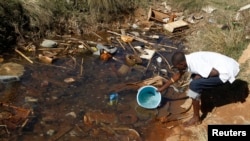An outbreak of typhoid in Zimbabwe's capital has killed two people and is affecting dozens more, raising fears that the southern African country's water and sanitation problems are far from over.
Officials say that so far, 126 cases of typhoid have been confirmed in Harare since the start of the rainy season in Zimbabwe about two months ago. There are more than 1,000 other suspected cases nationwide.
But Dr. Prosper Chonzi, who heads the Harare health department, said there was no need to panic.
"What we are doing is to educate the public on awareness issues to do with typhoid — what it is, how it is spread, how to avoid getting it," Chonzi said. "We are also discouraging people from consuming food from undesignated premises."
Harare city crews, he added, were clearing blocked sewer pipes in Mbare township and trying to ensure supplies of fresh water in affected areas.
Problems persist
However, a visit to those and other parts of Harare on Wednesday told a different story. Faucets were dry, sewer water could be seen flowing, and some people were using water from open sources like lakes and rivers.
Itai Rusike, executive director of the Community Working Group on Health, said President Robert Mugabe's government did not learn much from the 2008-09 rainy season, when an outbreak of cholera killed more than 4,000 people in Zimbabwe.
"The fundamental health issues that were supposed to have been attended to from the earlier crisis have not been attended to," Rusike said. "Authorities are taking advantage of the outdated Public Health Act that we are using, enacted in 1924. Public health trends have changed [since then]. This is why you find that it is easier for the city of Harare to pollute our water bodies and pay the fine, [a] very small fine."
The pollution he referred to is raw sewer water discharging into rivers, which some people rely on for daily use. Those using the contaminated river can easily contract waterborne diseases such as typhoid and cholera.
Typhoid, an infectious bacterial fever, can be treated with antibiotics, but it still kills more than 220,000 people worldwide each year, according to an estimate from 2014 reported by the World Health Organization.







